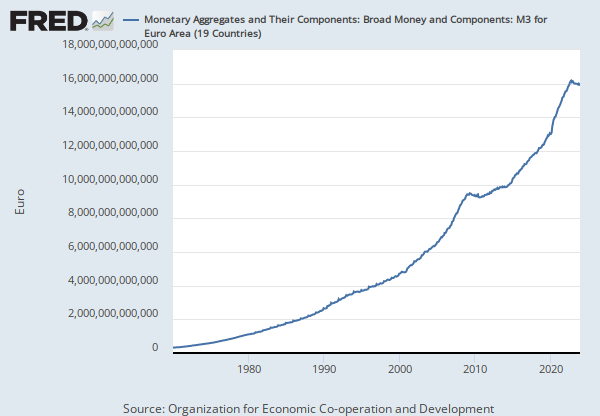Observations
2022: 11,302,909,000,000.00000 | Euro, Not Seasonally Adjusted | Annual
Updated: Dec 12, 2023 3:06 PM CST
Observations
| 2022: | 11,302,909,000,000.00000 | |
| 2021: | 11,295,576,000,000.00000 | |
| 2020: | 10,269,456,000,000.00000 | |
| 2019: | 8,948,846,000,000.00000 | |
| 2018: | 8,284,400,000,000.00000 |
Units:
Frequency:
Write a custom formula to transform one or more series or combine two or more series.
You can begin by adding a series to combine with your existing series.
Now create a custom formula to combine or transform the series.
Need help?
For example, invert an exchange rate by using formula 1/a, where “a” refers to the first FRED data series added to this line. Or calculate the spread between 2 interest rates, a and b, by using the formula a - b.
Use the assigned data series variables (a, b, c, etc.) together with operators (+, -, *, /, ^, etc.), parentheses and constants (1, 1.5, 2, etc.) to create your own formula (e.g., 1/a, a-b, (a+b)/2, (a/(a+b+c))*100). As noted above, you may add other data series to this line before entering a formula.
Finally, you can change the units of your new series.
Add the minimum, maximum, and average calculations of selected bars to the graph
Write a custom formula to transform one or more series or combine two or more series.
You can begin by adding a series to combine with your existing series.
Now create a custom formula to combine or transform the series.
Need help?
For example, invert an exchange rate by using formula 1/a, where “a” refers to the first FRED data series added to this line. Or calculate the spread between 2 interest rates, a and b, by using the formula a - b.
Use the assigned data series variables (a, b, c, etc.) together with operators (+, -, *, /, ^, etc.), parentheses and constants (1, 1.5, 2, etc.) to create your own formula (e.g., 1/a, a-b, (a+b)/2, (a/(a+b+c))*100). As noted above, you may add other data series to this line before entering a formula.
Finally, you can change the units of your new series.
Add the minimum, maximum, and average calculations of selected bars to the graph
Data in this graph are copyrighted. Please review the copyright information in the series notes before sharing.
Notes
| Title | Release Dates | |
|
|
||
| M1 for the Euro Area | 2013-06-03 | 2023-09-08 |
| Monetary Aggregates and Their Components: Narrow Money and Components: M1 and Components: M1 for Euro Area (19 Countries) | 2023-09-09 | 2023-12-09 |
| Source | ||
|
|
||
| Organization for Economic Co-operation and Development | 2013-06-03 | 2023-12-09 |
| Release | ||
|
|
||
| Main Economic Indicators | 2013-06-03 | 2023-12-09 |
| Units | ||
|
|
||
| National Currency | 2013-06-03 | 2023-09-08 |
| Euro | 2023-09-09 | 2023-12-09 |
| Frequency | ||
|
|
||
| Annual | 2013-06-03 | 2023-12-09 |
| Seasonal Adjustment | ||
|
|
||
| Not Seasonally Adjusted | 2013-06-03 | 2023-12-09 |
| Notes | ||
|
|
||
|
OECD descriptor ID: MANMM101 OECD unit ID: ST OECD country ID: EA17 All OECD data should be cited as follows: OECD, "Main Economic Indicators - complete database", Main Economic Indicators (database),http://dx.doi.org/10.1787/data-00052-en (Accessed on date) Copyright, 2016, OECD. Reprinted with permission. |
2013-06-03 | 2023-09-08 |
|
OECD Descriptor ID: MANMM101 OECD unit ID: EUR OECD country ID: EA19 All OECD data should be cited as follows: OECD, "Main Economic Indicators - complete database", Main Economic Indicators (database), https://dx.doi.org/10.1787/data-00052-en (Accessed on date) Copyright, 2016, OECD. Reprinted with permission |
2023-09-09 | 2023-12-09 |
Release Tables
Related Data and Content
Data Suggestions Based On Your Search
Content Suggestions
Other Formats
Related Categories
Releases
Tags
Permalink/Embed
modal open, choose link customization options
Select automatic updates to the data or a static time frame. All data are subject to revision.









